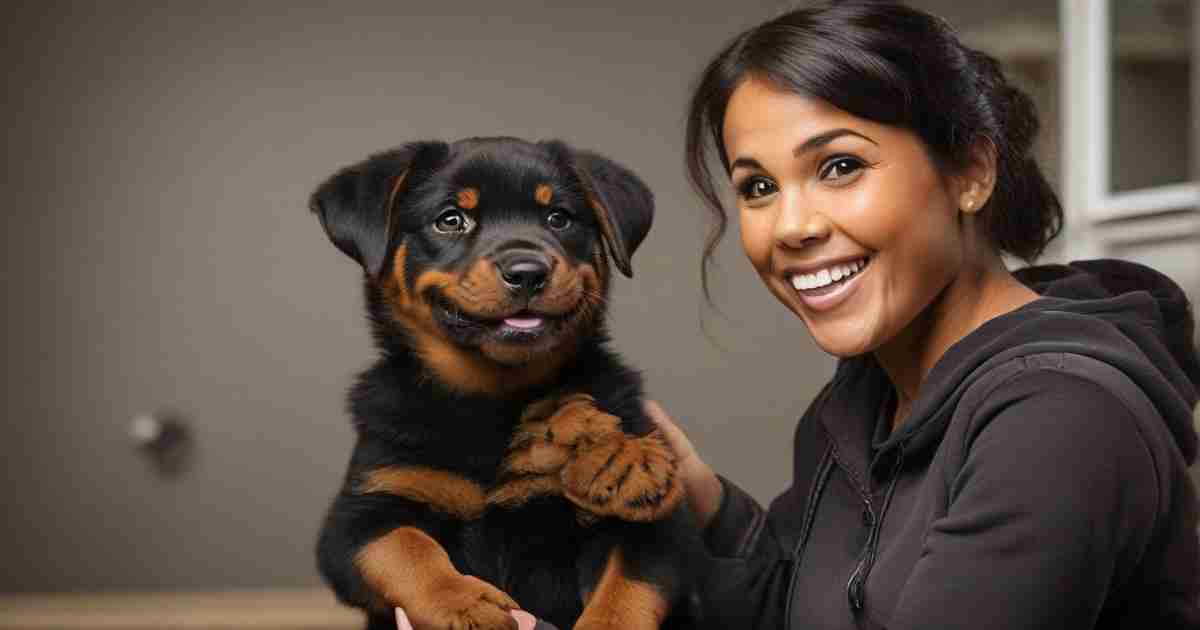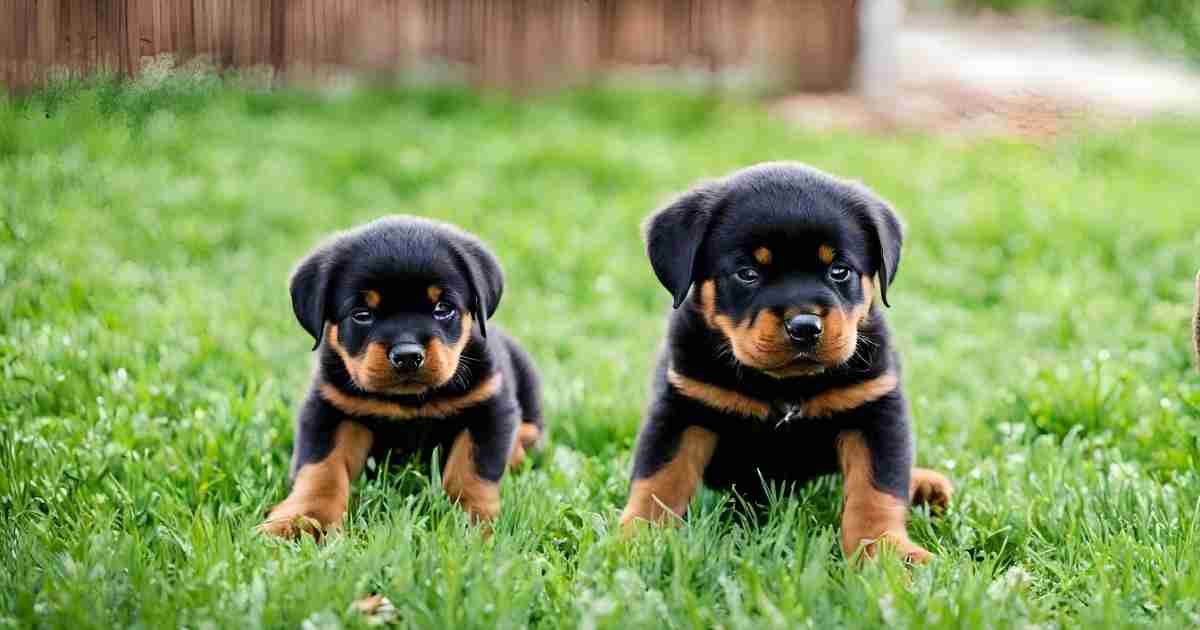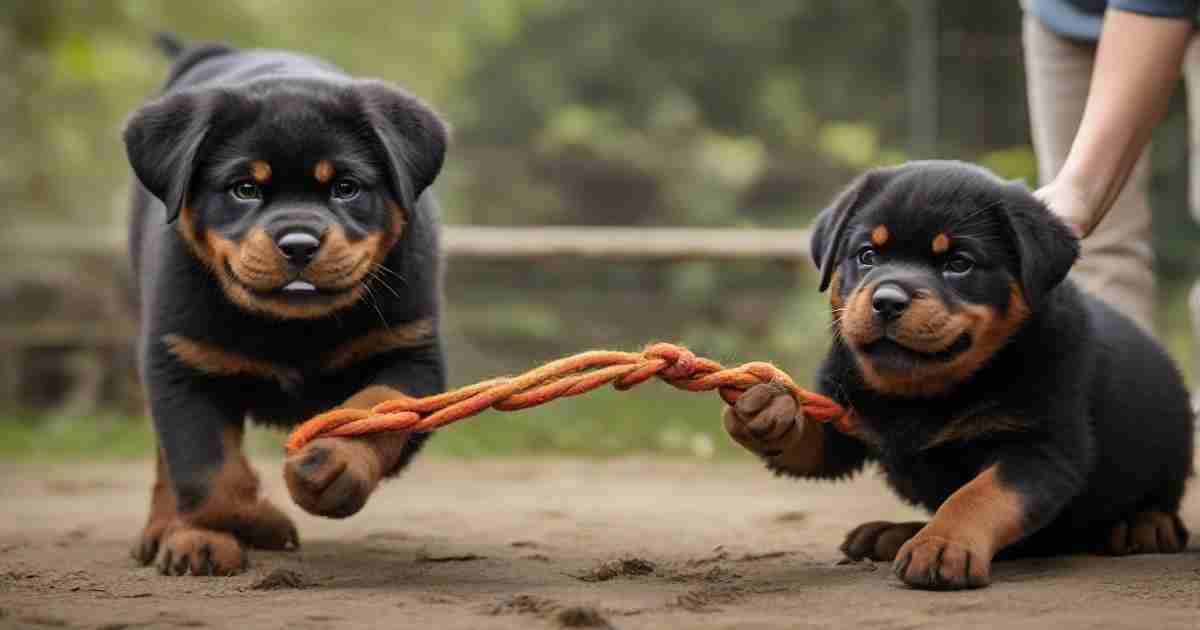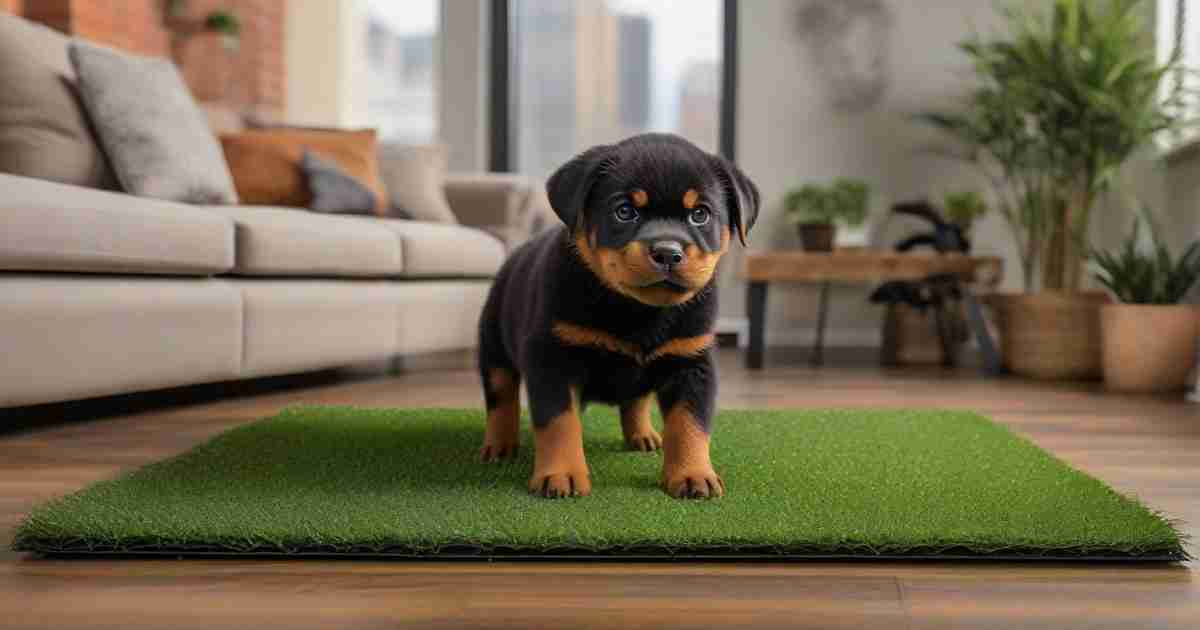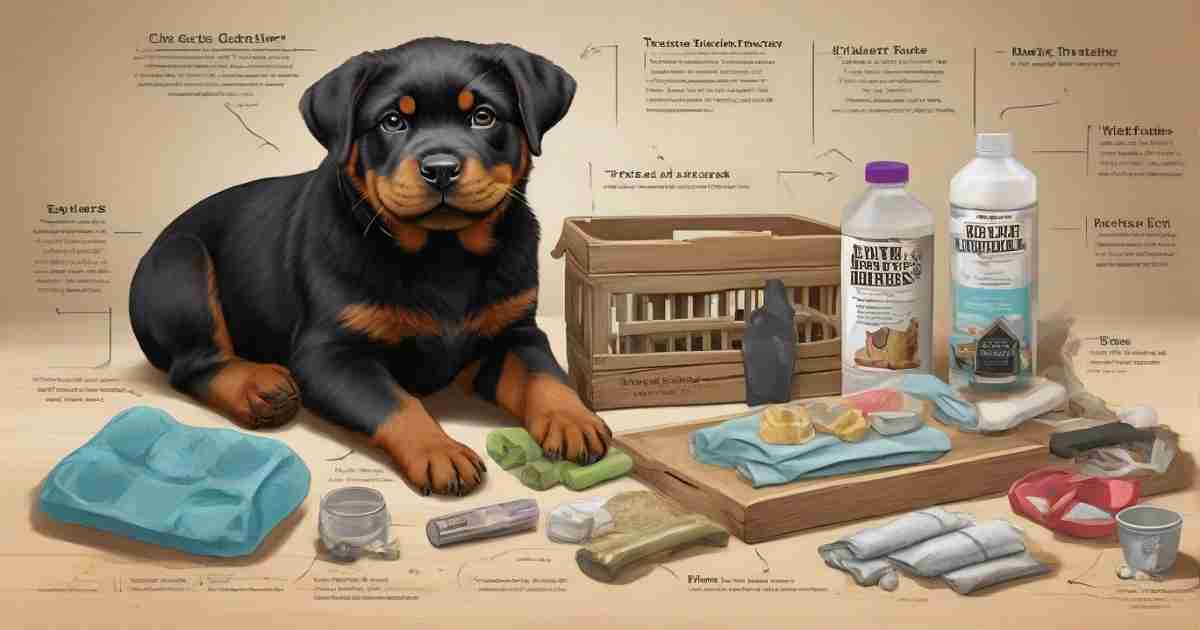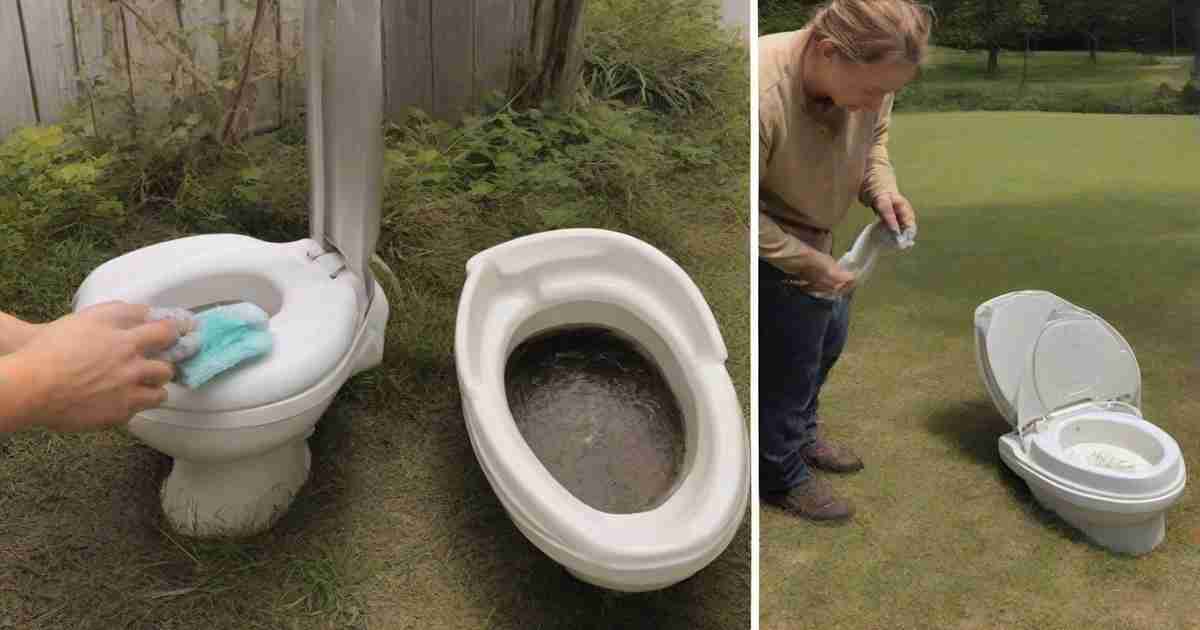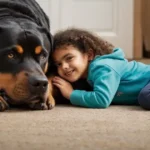Potty training your Rottweiler puppy is no small feat, but with the right techniques and a heaping dose of patience, even the most stubborn pup can be housebroken.
The key to success lies in understanding this clever yet hardheaded breed. Rottweilers are working dogs at heart, so they respond best to structure, consistency, and positive reinforcement when potty training.
Whether you’re struggling with frequent accidents, confused by your pup’s signals, or need tips for apartment dwelling, this comprehensive guide breaks down the process into simple, manageable steps.
With a strategic plan tailored to your rottie, you’ll have your new best friend housebroken quickly.
Preparing for Housebreaking Your Rottweiler Puppy
Getting your pup and home up for success is the first step in tackling rottweiler potty training.
This clever working breed thrives when they know what to expect, so creating structure immediately lays the groundwork for developing good habits.
Setting Up the Indoor Potty Zone
Designating an appropriate indoor potty area for your pup will ease housebreaking.
This gives them an acceptable place to relieve themselves until they build enough bladder and bowel control to last through the night or hold it while you’re away at work.
Consider the following options:
- Pee pads: Disposable or washable ones give your pup a designated place to go inside. They have a scent that attracts the puppy to urinate on them.
- Fake grass patches: These imitation grass pads feel natural under the paw and mimic going potty outside. The grass smells like real grass to trigger urination.
- Litter boxes: Yes, you can litter box train your rottweiler! Use a non-clumping litter without scented crystals.
Whichever option you choose, stick to it consistently and praise your puppy each time they use their indoor potty spot properly. Gradually transition to all outdoor potties as their control improves.
Preparing Your Outdoor Potty Zone
Choosing an ideal outdoor potty area is crucial for Rottweiler Potty Training’s success. This space should be:
- Easily accessible from the door to avoid accidents en route
- Free from loud noises and distractions which may scare puppies
- Sheltered enough for any weather conditions, so it’s always useable
Initially, bring your Rottweiler pup to this zone on a leash every time to reinforce that this is THE bathroom spot.
Use a verbal cue like “Go Potty,” then praise excitedly when they go to the designated place. The scent triggers will signal to your pup that this area means taking care of business!
Supplies You’ll Need Handy
Having the right supplies ready will make a huge difference during the puppy housebreaking process:
Perfect Puppies Crate
- An appropriately sized wire crate with a divider panel provides a cozy den feel without too much extra space. This keeps your puppy contained when you can’t actively supervise them indoors.
Nature’s Miracle Enzyme Cleaner
- Puppies have accidents, and it’s a fact of life! An enzymatic cleaner designed for pet messes completely removes all traces of odor and residue so your pup won’t be repeatedly drawn back to the same soiled spots.
Irresistible Smelly Treats
- Stinky, tasty training treats like small bits of cheese, hot dogs, chicken, or liver motivate pups to want to perform. Always have some in your pocket!
Lightweight Leash
- Clip a thin leash on your pup’s collar anytime they are loose in the house so you can promptly direct them outside if they indicate a need to go. Constant supervision prevents indoor accidents.
With the indoor and outdoor potty zones and supplies ready, you’ve laid the groundwork for success for Rottweiler potty training! Now, it’s time to establish a predictable routine.
Establishing a Consistent Potty Training Routine
Once you have the essentials ready for your rottweiler puppy’s potty training, it’s time to establish a predictable routine.
This breed thrives when they know what to expect. A steady schedule of feeding, potty breaks, praise and crate time sets them up for success.
Feeding Time
- Feed your puppy 3-4 times per day on a consistent schedule
- Take the pup out 15-30 minutes after each meal for a potty break
- Remove food in between mealtimes
Potty Breaks
- Take your pup outside every 30 minutes (adjust based on age)
- Also, bring out 5-10 minutes after drinking, playing, waking up
- Use a verbal cue like “go potty,” then praise immediately after they go
Crating
- Place puppy in crate for naps and when you can’t supervise
- One hour crated per month of age is a good rule of thumb
- Never use the crate for punishment to avoid negative associations
Sticking to this predictable routine teaches your rottweiler that outside is the place to go potty. Keep treats in your pocket to motivate them. Be patient – potty training this strong-willed breed takes persistence through the inevitable accidents. The payoff of having a devoted, well-mannered canine companion is worth every effort!
Managing Accidents and Troubleshooting Issues
Even the most diligent rottweiler potty training regimens hit occasional snags. Puppy bladders and bowel control take time to strengthen, so accidents inevitably happen in that learning process. How you handle these setbacks can impact your pup’s ongoing housebreaking success.
Cleaning Up Accidents 101
Thorough accident cleanup is vital so your rottweiler pup isn’t repeatedly drawn back to the same soiled spots. Here’s a bulletproof process:
- Blot up urine promptly with an absorbent towel. For other messes, remove the solids first.
- Rinse the area thoroughly with cool water and soak up the moisture.
- Spray an enzymatic cleaner formulated for pet stains liberally on the spot. Use enough volume to penetrate pads or carpets.
- Let the enzymatic cleaner soak in for 5-10 minutes. This gives the active ingredients time to break down the odor-causing compounds.
- Blot the area with clean towels to absorb all moisture and cleaner. Speed the drying process with fans or heaters.
- Once completely dry, spray a pet odor neutralizer over the area. This adds an extra layer of protection.
- Return your Rottweiler to the cleaned area and praise them for using an appropriate potty zone. This prevents residual anxiety about past discipline.
Repeat this thorough clean-up process anytime a mishap occurs. Pay special attention to soiled rugs, cushions, and mattresses since odors are deeply embedded. Discard items if stains or smells persist after professional-level treatment.
Why Accidents Happen and How to Pivot
There are several common reasons potty training may hit roadblocks with your rottweiler pup:
- Bladder or bowel capacity isn’t fully developed
- Illness like UTIs or diarrhea interfere
- Stress from changes or new environments
- Overdue for a potty break
- Seeking attention from family members
- Marking territory with urine droplets
Pinpointing the cause of frequent accidents is key to getting your pup’s house training back on track. If illness or anxiety seems potentially involved, consult your veterinarian. They can provide medical advice, screening and even medication, if necessary, to help get your pup comfortable again.
When should you consult your vet? If illness or emotional distress seems potentially involved in your pup’s accidents or setbacks, it’s time to enlist the experts!
- What medical issues might interfere with training? Urinary infections make pups need to go more often, while conditions like diarrhea, colitis and anxiety can all contribute to uncontrolled elimination.
- Your vet can run tests, provide treatment if required, and offer behavioral guidance tailored to your Rottie’s needs. This gets their health stabilized so progress can resume.
- For other common causes, try spacing out potty trips and incentive rewards, closely crating your dog if you can’t supervise 100%, scanning for any lapses in your home potty routine, or simply allowing more time for habits to solidify with your pup’s evolving body.
- Significant changes like a move or new family member can also temporarily slow progress, so remain flexible.
- Consistency and teaching your pup that going potty outside leads to rewards are vital for Rottweiler’s housebreaking victory!
- This loyal breed bonds intensely when raised with patience. Yes, that famous Rottie stubborn streak might emerge. But stay positive, immediately reinforce correct behaviors, thoroughly clean any indoor accidents and consistency will click before you know it!
- Add compassion when communicating with your clever companion; your patience will reap lifelong loyalty.
Implementing Positive Reinforcement Potty Training
- Rottweilers live to work. They crave jobs and clear direction, so positive reinforcement training matches this highly driven breed’s eagerness.
- Motivation through rewards and praise taps into their aim to please rather than requiring correction.
- What motivates each unique Rottie? Make a game by figuring out your pup’s potty training motivators.
- Try bits of chicken, throwing fetch balls, a fun game of tug, excited belly rubs, and special car rides. Determine their top temptations for maximum progress.
- Avoid scolding when accidents happen – it can contribute to stubborn resentment in these willful pups.
- Instead, gently redirect to the correct spot, compassionately clean up afterward, and double down on encouraging outdoor potties with over-the-top celebrations of success! This positive potty dance becomes their ultimate goal!
Identifying Your Pup’s Motivators
The first step is determining what excites your canine trainee during those crucial learning moments. Every Rottweiler has unique motivations. Potential options include:
- Treats: Small soft treats, tiny pieces of chicken, hot dogs or cheese, spray cheese
- Toys: Fetch balls, plush animals, tug ropes, squeakers
- Play: Running, chasing games, wrestling, keep away
- Affection: Verbal praise, belly rubs, brushing, massages
- Outings: Car rides, walks, hikes, outdoor exploration
Try various rewards during initial potty training sessions to see what makes your puppy’s tail wag.
Maintain an arsenal of enticing motivators you can leverage. For extra impact, reserve special high-value rewards exclusively for potty success.
Delivering Rewards at the Right Time
Timing matters enormously when applying positive reinforcement during rottweiler potty training.
You must reward the exact moment the desired behavior happens before your puppy becomes distracted.
When your pup finishes potting in the designated outdoor zone, immediately provide enthusiastic praise and give them their preferred motivator.
Continue reinforcing for 30 seconds while they connect the trigger, behavior and reward. This imprints going potty outside = AWESOME!
Setting Your Rottweiler Up for Success
While positive reinforcement hinges on motivating rewards, you must also mindfully engineer opportunities for your trainee to earn the coveted prizes. For example:
- Take your pup to their established outdoor potty area whenever you suspect they need to urinate rather than waiting for them to indicate a need
- Attach the lightweight house line to make prompt potty escorts easier
- Keep stinky, delicious treats in your pocket during times they tend to eliminate
- Direct all successful outdoor potties with a consistent verbal cue like “Go Potty.”
Removing accidents indoors also prevents practicing undesirable habits. Confine your rottweiler puppy in their crate anytime you cannot focus on their signals actively.
Frequent supervision and scheduling potty breaks around mealtimes, naps and play sessions further promote timely trips outside.
With thoughtful shaping techniques and irresistible motivators, you can achieve amazing house training results with your determined rottweiler!
Celebrate all progress and remain an infinitely patient, benevolent leader. Your investment will pay back tenfold with your clever companion’s loyalty.
Advancing Through Key Potty Training Stages
Rottweiler potty training occurs gradually in manageable steps, not overnight. Expect accidents and backsliding even after periods of success.
This intelligent breed flourishes with patient guidance tailored to their developmental abilities at each phase.
8 – 10 Week Puppy House Training Considerations
During the first few months before full vaccination protection, restrict your pup’s outdoor access to your enclosed yard, free from contamination. Inside, focus on:
- Acclimating puppies to their designated indoor potty space
- Beginning to establish a predictable feeding and relief schedule
- Providing ample stimulation and free play to burn puppy energy
- Selecting a cue like “Get Busy” for eventual outdoor training
Since baby rottweiler bladders can only hold urine for 1-2 hours max, take your pup out frequently whenever they awake from naps or finish meals.
Crate training allows the forced breaks needed to strengthen bowel and bladder muscles.
12 Week Old Rottweiler Housebreaking Priorities
After the last round of puppy shots, outdoor socialization becomes safe. Now is the time to:
- Introduce your pup to their designated outdoor bathroom area
- Reinforce the verbal potty cue paired with trips to this location
- Extend intervals between indoor pee pad availability
- Supervise closely when loose in the house; leash when unwatched
- Celebrate all outdoor potties enthusiastically!
During this milestone, a rigid routine prevents mishaps. Adhere to a consistent feeding schedule and continue creating when you cannot actively focus on your pup. Confinement times can extend to 4 hours, stretching capacity.
6 Month+ Rottweiler Housetraining Considerations
Once your rottweiler reaches 6 months, their capacities approach adult levels. Key steps now include:
- Phasing out indoor potties completely by removing pads/fake grass
- Lengthening intervals between outdoor potty breaks
- Supervising loosely vs. constantly without leashing
- Containing unsupervised times to 6 hours maximum
- Troubleshooting any occasional accidents compassionately
Stay vigilant even after your Rottweiler seems fully housebroken to prevent backslides.
Adolescent independence may temporarily strain prior perfect habits. Be patient and persistently motivate outdoor successes until routines stick long-term.
With realistic expectations tailored to your pup’s evolving abilities, you can smoothly navigate every stage of rottweiler potty training!
Celebrate all progress and keep perspective when encountering normal puppy challenges.
Your beloved companion will repay your guidance a thousand times throughout your life together!
Additional Tips and Special Considerations For Rottweiler Potty Training
Regardless of your housing situation or lifestyle factors, you can achieve rottweiler potty training success with creativity and commitment!
Here are tips for overcoming common obstacles:
Small Space and Apartment Dwelling
Limited outdoor access poses an extra challenge when housebreaking your Rottie pup. Try these solutions:
- Designate an indoor potty space with fake grass or a tray of sod
- Use pee pads or newspapers if your landlord disapproves of indoor messes
- Take your pup out on a schedule to the nearest patch of outdoor grass
- Train your Rottweiler to go on command for hurried sidewalk potties
- Consider potty training apparatuses like Fresh Patch subscription services
While less convenient, urban and apartment potty training is feasible with realistic expectations about your pup’s abilities.
Juggling a Busy Schedule
Making time for frequent potty breaks can be tough when you juggle long work hours. Adjustments like these help:
- Arranging midday dog walker visits or daycare drop-offs
- Coordinating family members or friends to take turns
- Setting up a puppy-proof room rather than creating while gone
- Establishing a grassy potty area on your balcony or patio
As your Rottweiler’s control improves around 6 months, they can wait longer between breaks. However, maintaining a schedule still prevents accidents, so commit time.
Troubleshooting Tricky Medical Issues
Occasionally, an illness or health condition impedes house training progress in rottweilers:
- Urinary tract infection makes pups need to urinate more frequently and urgently
- Gastrointestinal issues like colitis cause uncontrolled pooping
- Separation anxiety when left triggers inappropriate elimination
- Noise phobia or storms frighten pups into having accidents
Consult your veterinarian immediately if you suspect physical or emotional issues are causing potty training setbacks.
Medical or behavioral intervention may be required to help get your rottweiler back on track. Patience and working closely with experts facilitate the process.
With creative problem-solving tailored to your unique situation, you can power through potty training pitfalls to earn your clever rottweiler’s loyalty and obedience.
Don’t hesitate to enlist others to share puppy parenting duties, either! Consistency, medical rule-outs, and unwavering commitment set you both up for success.
Choosing the Right Potty Training Method for Your Rottweiler
With so many housebreaking techniques, how do you select the best approach for your headstrong rottweiler pup? Consider these factors when deciding:
Your Pup’s Age
- Under 12 weeks: Focus on establishing an indoor potty area
- 12-16 weeks: Introduce outdoor zone and verbal cues
- 16+ weeks: Gradually transition fully to outdoor potties
Match training methods to developmental abilities at each stage.
Your Household Activity Level
- Homebodies: Consistent crating and trips outside
- Always on the go: Portable indoor potties for travel
- At work all day: Designated potty room set up
Tailor techniques to your schedule and availability for supervision.
Your Home Layout and Yard Access
- Apartment or high rise: Indoor grass patches or pads
- Townhouse with postage stamp yard: Quick curbside potties
- Private home and acreage: Doggy door for free access
Consider your unique home situation when selecting equipment.
Your Climate and Weather Extremes
- Hot desert: Access to fresh water and shade
- Extreme cold or snow: Quick potties to prevent exposure
- Frequent storms: Indoor potty space as backup
Ensure options suit your environmental conditions year-round.
Special Needs or Health Considerations
- Senior dogs with arthritis: Easy outdoor access
- Dogs on medication: Pads for urgent indoor access
- Nervous pups: Calming aids and positive association
Adapt your potty training methods to accommodate medical or behavioral challenges.
While most rottweiler owners succeed with crate training, your lifestyle may call for creative alternatives like indoor grass patches or designated bathrooms.
Remain flexible and patient with your intelligent companion. Consistency is key regardless of the equipment and techniques you select for your unique situation and limitations.
Understanding Your Rottweiler Puppy’s Potty Behaviors
Interpreting your young rottweiler’s biosignals is so important for potty training glory. Though those squishy puppy bladders and bowels strengthen over time, it’s gradual.
Typical Potty Development Stages
At 8 weeks:
- They’ll pee every half hour or less!
- Bowel movements follow all meals and naps. Be ready!
- There is no consistent warning they need to go. Just expect accidents!
- Careful scheduling is key during this stage.
By 12 weeks:
- The bladder expands to hold it for 2 hours if needed. Hallelujah!
- More conscious control means better signaling.
- Circling and sniffing may indicate needing to potty.
- Still, anticipate some misses as their bodily awareness grows.
At 6 months:
- Full urinary control like an adult. Yeah!
- Can wait 8+ hours comfortably between bowel movements.
- Clear potty signals allow for the prevention of most accidents now.
- However, continued supervision is still recommended.
Adjust your patience meter and training approach based on where your Rottie pup ranks age-wise! Preventing opportunities for mistakes through management facilitates skill-building during this crucial development.
Reading Your Rottweiler’s Potty Signals
- Wandering off suddenly means hurrying them outside!
- Intense sniffing or pacing while seeking privacy also screams that a potty run is needed.
- Approaching the door can signal a need for yard access, too.
Subtle signs could include staring at you, whining, or complete stillness. Decode your unique pup’s language.
When those signals happen, immediately use their potty cue phrase and hustle outside. Then celebrate when they get to the right zone! This connection quickly builds reliable bathroom manners.
Conclusion
The housetraining journey has ups and downs, but understanding your rottweiler puppy’s needs leads to success!
You’ll navigate smoothly with realistic expectations, enzyme cleaner stocked up, and positive reinforcement training tailored to each age. Stick to consistent routines, high-value outdoor potty rewards, and accident forgiveness.
Soon, your clever companion will figure out the yard is the only bathroom option! Housebreaking your faithful Rottie pup cements a forever mutual bond.
The extra diligence pays dividends with years of devoted companionship from your “good dog.”
Frequently Asked Questions
How old should I start potty training my Rottweiler puppy?
- Start laying groundwork around 8 weeks old, even though accidents will still happen initially.
What is the best method to potty train a Rottweiler?
- Consistent crate training combined with positive reinforcement has proven the most effective.
How long does it take to fully potty train a Rottweiler?
- With consistency, Rottweilers are reliably trained by 6-9 months old.
My Rottweiler was potty trained but now is having frequent accidents. What should I do?
- Rule out any medical issues first, then reinforce routines using unsupervised confinement.
I live in an apartment. Is potty training my Rottweiler going to be extra difficult?
- Apartment training requires realistic expectations and creative management using indoor potties.
